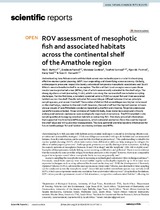ROV assessment of mesophotic fish and associated habitats across the continental shelf of the Amathole region

View/
Date
2021Author
Button, Rio E.
Parker, Denham
Samaai, Toufek
Metadata
Show full item recordAbstract
Understanding how fsh associate with habitats across marine landscapes is crucial to developing
efective marine spatial planning (MSP) in an expanding and diversifying ocean economy. Globally,
anthropogenic pressures impact the barely understood temperate mesophotic ecosystems and South
Africa’s remote Amathole shelf is no exception. The Kei and East London region encompass three
coastal marine protected areas (MPAs), two of which were recently extended to the shelf-edge. The
strong Agulhas current (exceeding 3 m/s), which runs along the narrow shelf exacerbates sampling
challenges. For the frst time, a remotely operated vehicle (ROV) surveyed fsh and their associated
habitats across the shelf. Results indicated fsh assemblages difered between the two principle
sampling areas, and across the shelf. The number of distinct fsh assemblages was higher inshore and
on the shelf-edge, relative to the mid-shelf. However, the mid-shelf had the highest species richness.
Unique visuals of rare Rhinobatos ocellatus (Speckled guitarfsh) and shoaling Polyprion americanus
(wreckfsh) were collected. Visual evidence of rhodolith beds, deep-water lace corals and critically
endangered endemic seabreams were ecologically important observations. The ROV enabled in situ
sampling without damaging sensitive habitats or extracting fish.
